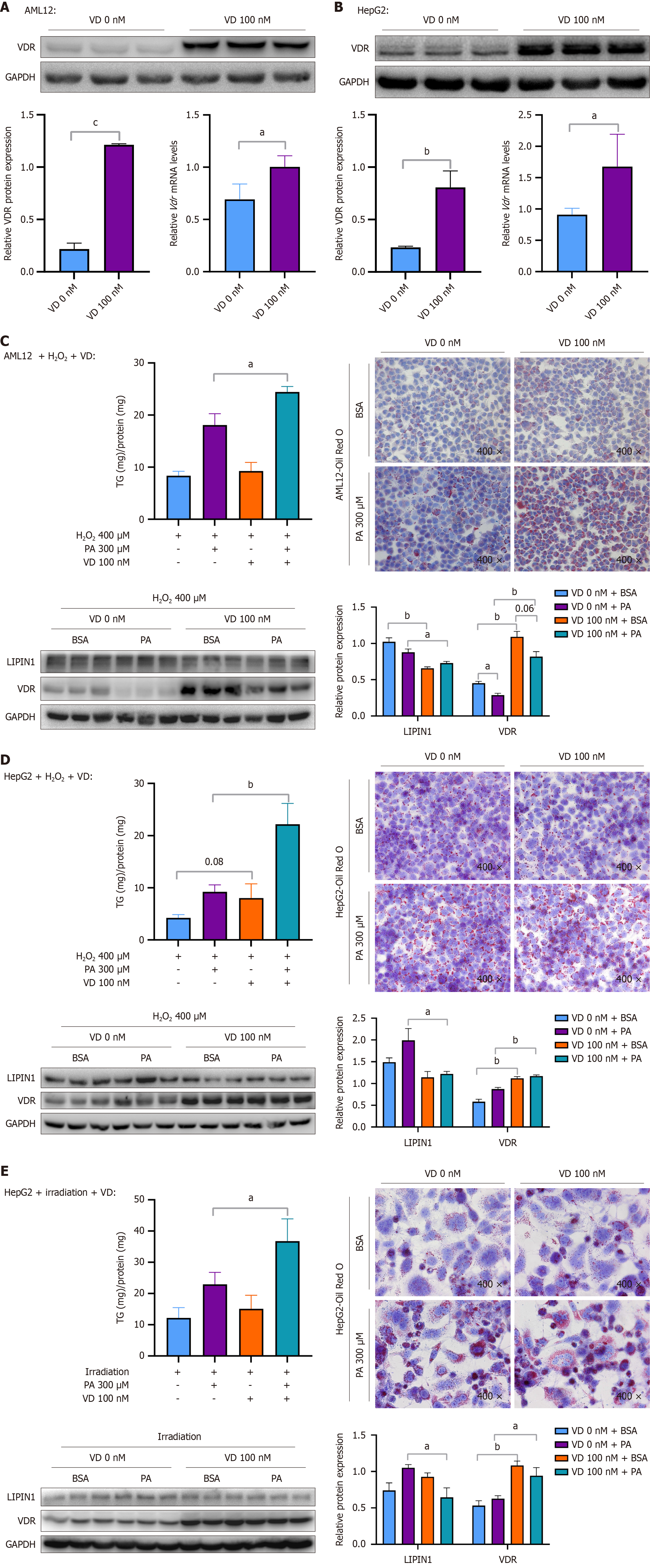Copyright
©The Author(s) 2025.
World J Gastroenterol. Apr 14, 2025; 31(14): 104117
Published online Apr 14, 2025. doi: 10.3748/wjg.v31.i14.104117
Published online Apr 14, 2025. doi: 10.3748/wjg.v31.i14.104117
Figure 7 The upregulation of vitamin D receptor aggravated palmitic acid-induced steatosis when cellular senescence was induced.
A: Protein expression level of vitamin D receptor (VDR) and corresponding quantitative results, and mRNA level of VDR in AML12 cells treated with vitamin D (VD) (100 nM) for 12 hours; B: Protein expression level of VDR and corresponding quantitative results, and mRNA level of VDR in HepG2 cells treated with VD (100 nM) for 12 hours; C-E: Cellular levels of triglycerides, Oil Red O staining (× 400), and protein expression levels of VDR and LIPIN1 and corresponding quantitative results after cellular senescence was induced and cells were treated with VD and palmitic acid (PA). AML12 cells were treated with hydrogen peroxide (H2O2) (400 μM) for 6 hours, treated with VD (100 nM) for 12 hours, and then costimulated with VD (100 nM) and PA (300 μM) for 24 hours (C); HepG2 cells were treated with H2O2 (400 μM) for 6 hours, treated with VD (100 nM) for 12 hours, and then costimulated with VD (100 nM) and PA (300 μM) for 24 hours (D); HepG2 cells were irradiated with 8 Gy of X-rays, treated with VD (100 nM) for 12 hours, and then costimulated with VD (100 nM) and PA (300 μM) for 24 hours (E). Protein and mRNA levels were normalized to those of glyceraldehyde-3-phosphate dehydrogenase. The data are presented as the means ± SDs. aP < 0.05. bP < 0.01. cP < 0.001. P calculated as determined via student’s t tests and one-way analysis of variance with Tukey’s correction. VDR: Vitamin D receptor; GAPDH: Glyceraldehyde-3-phosphate dehydrogenase; VD: Vitamin D; H2O2: Hydrogen peroxide; BSA: Bovine serum albumin; PA: Palmitic acid.
- Citation: Zhu F, Lin BR, Lin SH, Yu CH, Yang YM. Hepatic-specific vitamin D receptor downregulation alleviates aging-related metabolic dysfunction-associated steatotic liver disease. World J Gastroenterol 2025; 31(14): 104117
- URL: https://www.wjgnet.com/1007-9327/full/v31/i14/104117.htm
- DOI: https://dx.doi.org/10.3748/wjg.v31.i14.104117









